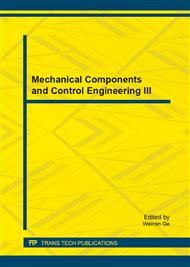p.289
p.294
p.298
p.302
p.306
p.310
p.314
p.318
p.322
Effect of Acrylamide Modified Liner on Properties of Self-Lubricating Spherical Plain Bearings
Abstract:
The effects of acrylamide modified liner on bonding properties and tribological properties of self-lubricating spherical plain bearings were explored by used of Instron5944 electronic universal testing machine and homemade spherical plain bearings friction and wear tester. The results showed that the bonding properties of bearings modified by acrylamide modified liner were much more improved than those of the unmodified bearings; Self-lubricating spherical plain bearing friction and wear properties and oscillating frequency obvious correlational dependence. With the increase of the oscillation frequency, the friction coefficient and the wear loss increased, while the friction temperature rose. The friction coefficient, wear loss and friction temperature of bearings modified were much more improved than those of the unmodified bearings. It showed that the liners after modification treatment can improve the tribological properties of self-lubricating spherical plain bearings.
Info:
Periodical:
Pages:
306-309
Citation:
Online since:
October 2014
Authors:
Price:
Сopyright:
© 2014 Trans Tech Publications Ltd. All Rights Reserved
Share:
Citation:


